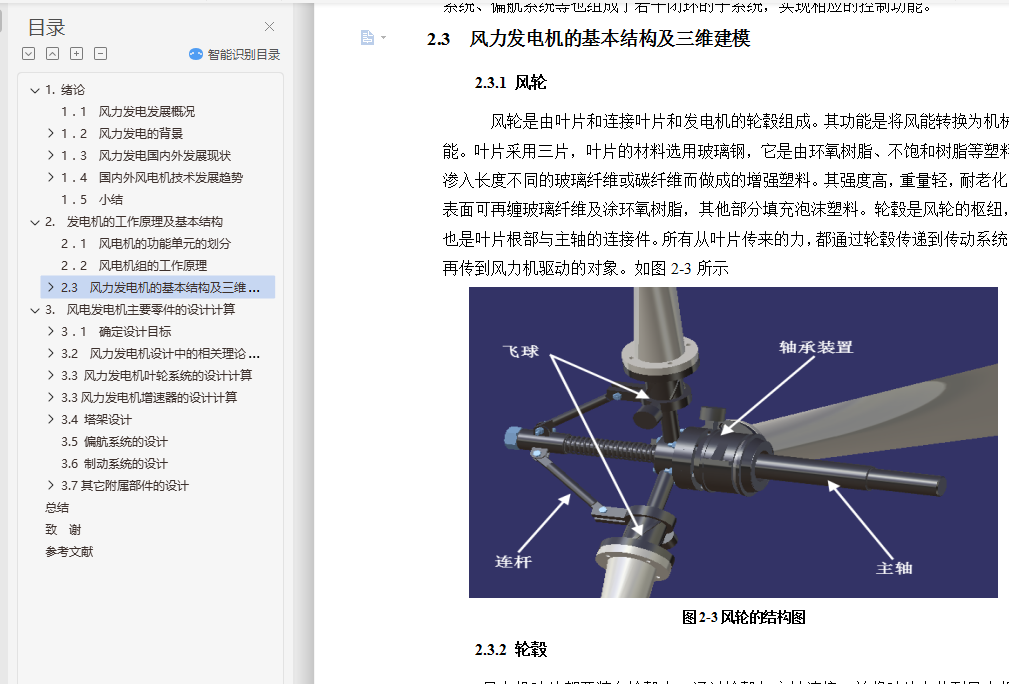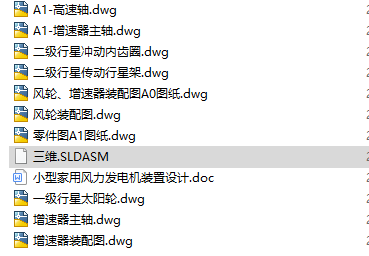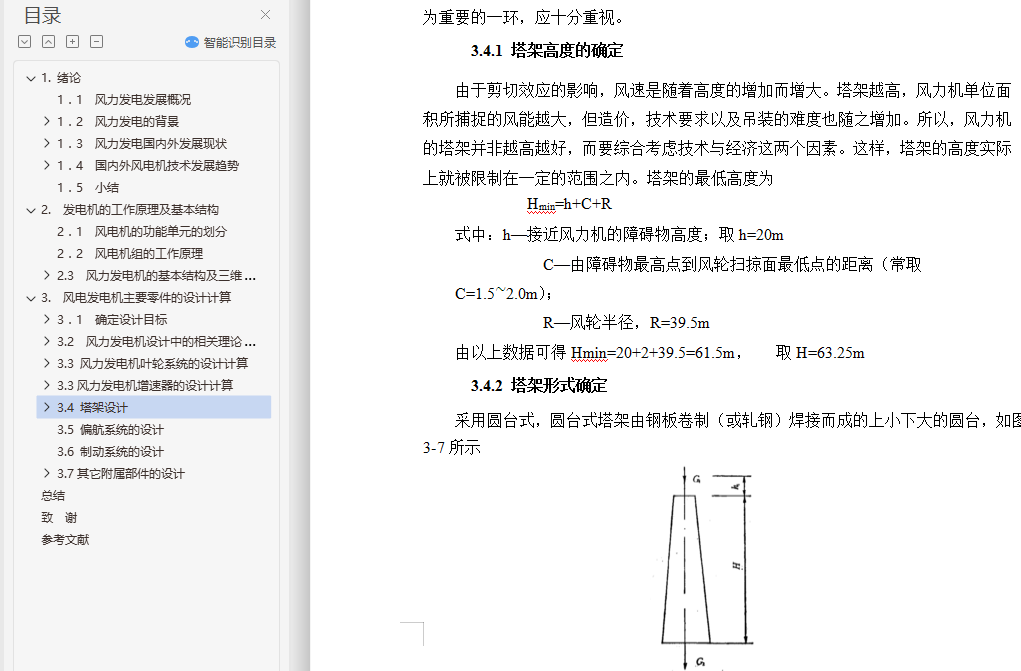摘 要
风力发电机组 (简称风电机)是将风能转化为电能的机械。风轮是风电机最主要的部件,由浆叶和轮毂组成。桨叶具有良好的空气动力外形,在气流作用下能产生空气动力使风轮旋转,将风能转换成机械能,再通过齿轮箱增速,驱动发电机转变成电能。在理论上,最好的风轮只能将约60%的风能转换为机械能。现代风电机风轮的效率可达到40%。风电机输出达到额定功率前,功率与风速的立方成正比,即风速增加1倍,输出功率增加8倍,所以同力发电的效益与当地的风速关系极大。
风力发电机由机头、转体、尾翼、叶片组成。每一部分都很重要,各部分功能为:叶片用来接受风力并通过机头转为电能;尾翼使叶片始终对着来风的方向从而获得最大的风能;转体能使机头灵活地转动以实现尾翼调整方向的功能;机头的转子是永磁体,定子绕组切割磁力线产生电能。风机工作稳定是一个非常重要的问题,通过回顾过去成功的小型风力发电机组的设计,就可以发现它们的共同特点是简单,只有简单才可能做到活动部件少,应力连续而无突变,才能使小型风力发电机工作稳定。所以本课题是设计一款结构简单、使用方便、成本低、易维修、使用寿命长的小型风力发电机。
本文设计了一台功率为2KW的风力发电机,其为水平轴风力发电机,由风轮、发电机、偏航装置、控制系统、塔架等部件组成。对其叶片,行星齿轮增速器,塔架等进行了详细的方案选择及设计计算。
关键词:风力发电;水平轴风力机;叶片;增速器
Abstract
Wind turbine is a machine that converts wind energy into electric energy.The wind turbine is the main component of the wind motor, which is composed of the slurry blade and the wheel hub.The blade has a good aerodynamic shape, it can produce aerodynamic force to rotate the wind wheel, convert wind energy into mechanical energy, and then drive the generator into electric energy by gearbox increasing speed.In theory, the best wind turbines can only convert about 60% of wind energy into mechanical energy.The efficiency of wind turbine of modern wind motor can reach 40.Before the output of the wind motor reaches the rated power, the power is proportional to the cubic of the wind speed, that is, the wind speed increases by 2 times, the output power increases by 8 times, so The benefit of power generation is closely related to the local wind speed.
The wind turbine consists of a nose, a rotor, a tail wing and a blade.Each part is important. The functions of each part are as follows: the blade is used to accept the wind and is converted into electricity through the nose; the tail wing makes the blade always face the direction of the wind to obtain the maximum wind energy;The rotor of the rotor is a permanent magnet, and the stator winding cuts the magnetic force line to generate electric energy.Fan stability is a very important problem. By reviewing the successful design of small wind turbines in the past, we can find that their common characteristics are simple, only simple can achieve less moving parts, continuous stress. Without mutation, the small wind turbine can work stably.So this project is to design a small wind turbine with simple structure, easy use, low cost, easy maintenance and long service life.
A wind driven generator with a power of 2KW is designed . It is a horizontal axis wind power generator . It is composed of wind wheel , generator , yawing device , control system , tower and so on . Detailed scheme selection and design calculation are carried out for its blade , planetary gear speed increaser and tower .
Keywords: wind power generation; horizontal axis wind turbine; blade; accelerator
目录
1. 绪论 5
1.1 风力发电发展概况 5
1.2 风力发电的背景 6
1.2.1 能源危机 6
1.2.2 环境危机 6
1.2.3 可再生能源开发利用 7
1.2.4 风能开发利用 8
1.3 风力发电发展现状 8
1.3.1 国外风电发展现状 9
1.3.2 国内风电发展现状 10
1.4 国内外风电机组发展趋势 11
1.4.1 产业集中是总的趁势 11
1.4.2 水平轴风电机组技术成为主流 11
1.4.3 风电机组单机容量持续增大 12
1.4.4 变桨变速功率调节技术得到广泛采用 12
1.4.5 双馈异步发电技术仍占主导地位 12
1.4.6 大型风电机组关健部件的性能日益提高 13
1.4.7 智能化控制技术提高了风电机的可靠性和寿命 13
1.4.8 叶片技术发展趋势 13
1.4.9 风电场建设和运营的技术水平日益提高 14
1.4.10 恶劣气侯环境下的风电机可靠性得到重视 14
1.5 小结 15
2. 发电机组的基本功能构成及工作原理 16
2.1 风电机组的基本功能构成 16
2.2 风电机组的工作原理 17
2. 3 风力发电机的基本结构及三维建模 19
2.3.1 风轮 19
2.3.2 轮毂 19
2.3.3 主轴 20
2.3.4 齿轮箱 21
2.3.5 发电机 21
2.3.6 偏航系统 22
2.3.7 对风装置 23
2.3.8 塔架和基础 23
2.3.9 附属部件 23
3. 风电发电机主要零件的设计计算 25
3.1 确定设计目标 25
3.1.1 风力机总体设计方案 25
3.1.2 风力机零件设计方案 27
3.2 风力发电机设计中的相关理论及概念 28
3.2.1 风力机气动设计理论基础 28
3.2.2 叶片设计中的基本概念 31
3.3.风力发电机叶轮系统设计计算 33
3.3.1 叶轮的总体设计 33
3.3.2 叶片的设计计算 34
3.3.3 轮毂的选择 39
3.4 风力发电机增速器的设计计算 39
3.4.1 传动方案的确定 39
3.4.2 增速器基本设计要求及设计步骤 40
3.4.3 传动原理图 41
3.4.4 增速器各传动部件的材料及力学性能 42
3.4.5 第一级行星轮系传动设计 43
3.4.6 第二级平行轴圆柱直齿轮设计 44
3.4.7 第三级平行轴圆柱斜齿轮设计 45
3.4.8 行星齿轮具体结构的确定 45
3.5 塔架的设计 46
3.5.1 塔架高度的确定 46
3.5.2 塔架形式的确定 47
3.6 偏航系统的设计 47
3.7 制动系统的设计 48
3.8 其它附属部件的设计 49
3.4.1 机舱的设计 49
3.4.2 机座的设计 49
3.4.1 回转体的设计 49
总结 50
致谢 51
参考文献 52








